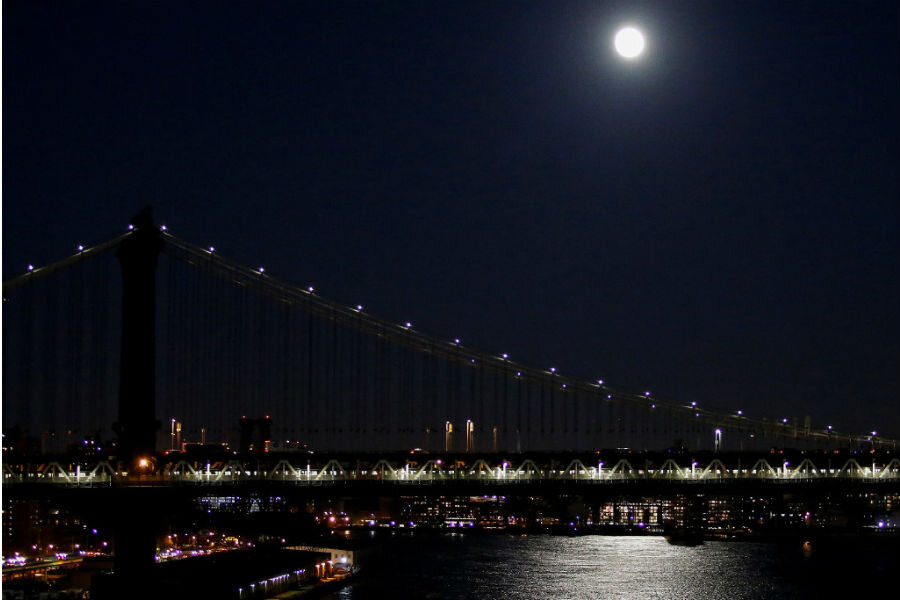Supermoon comes with supersized tides that could bring coastal flooding
Loading...
As the moon passed closer to Earth than at any point since 1948 early Monday morning, it put on a spectacular show, appearing bigger and brighter in the night sky than usual. But while many amateur astronomers looked up at the largest "supermoon" in 68 years travel across the sky last night, officials in coastal areas are keeping a wary watch earthward – specifically, at sea levels.
While the supermoon will not be quite as close to Earth Monday evening as it was in the morning, the moon is still much closer to our planet than usual. Because of this proximity, the moon is exerting a much stronger gravitational pull on the Earth's oceans than usual, creating higher tides than would ordinarily be expected at this time of year.
Across the East Coast, and especially in southern Florida, communities are preparing for potential flooding from these "king tides" caused by the supermoon. As climate change continues to melt Arctic ice and glaciers and raise ocean levels around the world, lunar events like this may have the potential to become far more destructive than they have been in the past.
A supermoon occurs because the moon orbits around the earth in an elliptical orbit. Since ellipses have an oval shape, rather than a perfectly circular curve, the moon is closer to the Earth at some points during its orbit than others. When the moon is at its closest position to the Earth in the ellipse, it is referred to as a perigee-syzygy. When the moon is at this closest point, it can be as much as 14 percent closer than when it is at the farthest point from the Earth (a point known as the apogee-syzygy), and appears to be as much as 30 percent brighter to observers on the ground.
The moon is not expected to get this close again until November 2034.
The extra-close proximity of this particular supermoon means the gravitational pull of the moon will have an exceptionally pronounced effect on ocean waters. As such, the supermoon is causing greater high and low tides than at any other time between 1948 and 2016. This, in turn, is sparking an increased flood risk along the East Coast during these so-called king tides.
"Tides are generally stronger when the moon is new or full since – at those phases the sun – earth and moon are all in a line, and the tidal effects of the sun and the moon are pulling on the earth's oceans in the same direction," Robert Boyle, associate professor of physics and astronomy at Dickinson College, tells The Christian Science Monitor in an email. "The distance between the moon and the earth also has a strong influence on tides so – in general – tides will be stronger during a supermoon and tidal flooding more likely. If, in addition, the earth is at its closest point to the sun – which happens during January – the effect is increased still more."
But while the moon may be partially to blame for flooding this week, the world has changed a great deal since 1948. Since then, carbon emissions have raised global temperatures and caused extensive melting of glaciers and Arctic ice. This year had the fifth lowest total Arctic ice coverage on record, and the second lowest minimum ice coverage (in a statistical tie with 2007), as the Christian Science Monitor previously reported.
As a result of the ice melting, sea levels have been rising at an increasing rate. According to the National Ocean Service, levels have been rising by about 0.6 inches every decade since 1900, but since 1992, that rate has increased to 1.2 inches per decade. That level of increase can be highly destructive when the difference between high tide and a flood in many low-lying coastal areas is measured in inches, not feet.
Some climate scientists point to king tides as a glimpse into the future of sea level rise. Climate models suggest rising seas will push daily high tides as far inland as today's king tides.
"By 2030, we expect up to another six inches of sea level rise to occur," Tiffany Troxler, director of Florida International University’s Sea Level Solutions Center, told CBS. "We might see another six inches on top of this."
In southern Florida, king tides happen once or twice a year, flooding many low-lying neighborhoods. But as sea levels rise, such flooding is expected to occur on a regular basis and king tides will become more of an issue, especially during supermoons of this magnitude.
"This all depends on location," Stephen Strader, geography and environmental science professor at Villanova University near Philadelphia, tells the Monitor in an email. "For instance, locations that are closer to sea-level and near the ocean will be subject to significant flooding with the high tides. Places like Miami, Ft. Lauderdale, Jacksonville, etc. have witnessed fairly significant flooding caused by high tides and the supermoon’s gravitational pull."
Drivers in the affected regions are being told not to drive through flooded areas, and some roads have already been closed due to flooding, which is expected to last through the remainder of the week in some places.
While most destructive floods are associated with storms and hurricanes on the coast rather than king tides, climate change will likely continue to make such extreme weather events more likely, thereby contributing to destructive flooding on both counts. And as Brian McNoldy, a tropical weather expert and Miami resident points out, the combination of the two can be especially destructive.
"Since records began in 1996 at Virginia Key, the top four high-water events have all been associated with nearby hurricanes, and typically ones that coincided with the September and October king tides," Mr. McNoldy told The Washington Post in October. "But on Sept. 27, the fifth highest water level was measured at the location, and there was no influence from a hurricane."








